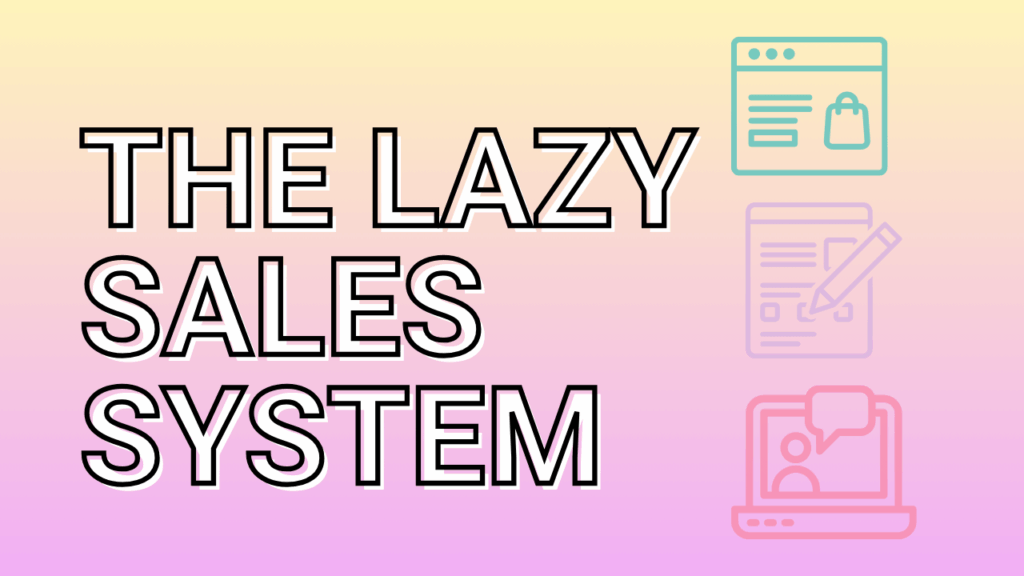The Lazy Sales System: The Secret to Booking Clients
 If you’ve ever hesitated to use an application form in your client process because you’re afraid people won’t fill it out, you’re not alone. But here’s the truth: if someone isn’t willing to answer a few intentional questions, they’re likely not ready—or the right fit—to work with you.
If you’ve ever hesitated to use an application form in your client process because you’re afraid people won’t fill it out, you’re not alone. But here’s the truth: if someone isn’t willing to answer a few intentional questions, they’re likely not ready—or the right fit—to work with you.
In this post, I’m sharing why a short, strategic application form is a non-negotiable part of your client booking system and how it fits into a bigger, simplified process I call the Lazy Sales System.
Why Service Providers Need an Application Form (Yes, Even You)
Let’s bust a myth real quick: an application form doesn’t scare away your ideal clients—it attracts them.
Here’s why:
-
It sets the tone that your services are intentional, structured, and valuable.
-
It filters out people who aren’t serious (saving you time and energy).
-
It signals that there’s a process—and high-level clients respect that.
Think about it: You’re looking for clients who are ready to do the work. If someone can’t answer three simple questions, they’re probably not there yet.
Common Mistakes People Make With Application Forms
Not all application forms are created equal. Here are some pitfalls to avoid:
-
❌ Asking too many questions
-
❌ Using language that makes people doubt if they’re ready
-
❌ Treating it like a full onboarding form
-
❌ Making it feel like a test instead of an invitation
This isn’t about gathering every single detail. It’s about capturing just enough to know if someone is a fit—and to start a meaningful, confident conversation.
How It Works Inside the Lazy Sales System
The Lazy Sales System has three steps:
-
Sales Page – Educates and pre-sells your offer.
-
Application Form – Qualifies leads and gathers context.
-
Booking Call – Final connection point to confirm fit.
Once someone reads your sales page and feels aligned, they move straight to your short application form. If they apply, that’s your signal: this person is warm, interested, and potentially ready to buy.
From there, they’re invited to book a call with you—but not just any call. A booking call, not a sales or discovery call. They’re already pre-sold. This is a vibe-check, not a pitch-fest.
Why the Booking Call Isn’t a Sales Call
By the time your potential client gets on a call:
-
They know your offer.
-
They’ve shown interest.
-
They’ve taken the initiative to apply.
Your job? Ask a few questions, confirm the fit, and guide them to the next step. No pitching. No convincing. Just clarity and connection.
When you set up your client booking flow this way, you:
-
✅ Save time and avoid no-show calls
-
✅ Attract serious leads
-
✅ Make your sales process more predictable
-
✅ Avoid emotional burnout from constantly “selling”
What to Include on Your Application Form
Keep it short, but powerful. Aim for 3–5 questions that help you assess:
-
What stage they’re at
-
What challenge they want help with
-
Why they’re interested in working with you
Examples:
-
“What’s your biggest challenge right now?”
-
“Which offer are you interested in?”
-
“Why do you want to work with me?”
Optional: Include a few checkboxes around readiness or budget if that’s relevant to your process.
Bonus: Why This System Is a Game-Changer for Your Marketing
Once you have this Lazy Sales System set up, your marketing has one clear goal: drive applications.
Not sales. Not DMs. Not content engagement.
Applications.
Why? Because 80% of people who apply through this system say “yes.” That means your marketing strategy becomes about getting more qualified leads into your pipeline—not about performing online 24/7.
Setting up a Lazy Sales System might feel counterintuitive if you’ve been told to “just get on calls” or “send a custom proposal.” But if you’re tired of feeling like you’re always winging it or trying to convince people to hire you, it’s time for a smarter way.
COURTNEY CHAAL
© Courtney Chaal 2024
Site Credit
Privacy Policy
Terms
Disclaimer